Exfoliating Face Masks: 8 Homemade Alternatives
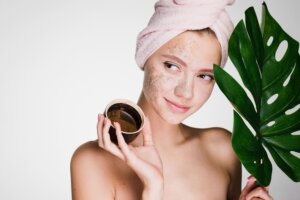
Exfoliation is a beauty treatment that should always be a part of your regular skincare routine. They help get rid of dead skin cells and impurities that can affect your skin’s appearance. Today, we’ll discover eight exfoliating homemade masks that you should incorporate into your routine.
Why use exfoliating masks?
Exfoliating masks can improve your skin in many ways. According to information published by the American Academy of Dermatology, exfoliation can help keep your skin glowing and free of dead skin cells.
They also help clear blocked pores and improve the effectiveness of topical skincare treatments by increasing absorption. However, the American Academy of Dermatology also states that it’s very important to do it properly since improper exfoliation can cause more harm than good.
Before you start, you’ll want to consider:
- Your skin type: sensitive skin requires special products, just like oily or dry skin.
- The product: in this case, since we’re just using natural ingredients, the products tend to be safe. That being said, it’s a good idea to do a little test before you use it to rule out adverse reactions.
- Gentle massage. As we mentioned before, exfoliation can be aggressive, which is why it’s important to apply with gentle, circular massage.
- Moisturizing. After you exfoliate, you should use a hydrating lotion to avoid dryness.
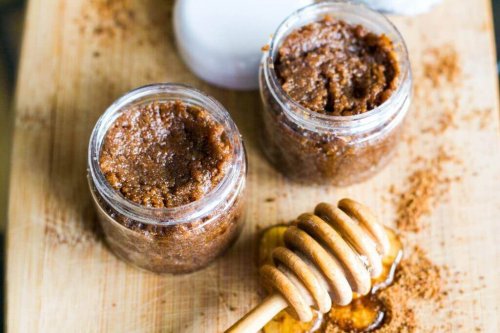
Homemade exfoliating masks
These days, there are many ways to exfoliate your skin. If you have any doubts about what’s best for your skin, ask a dermatologist. If you are looking for a natural solution, try some of these homemade masks.
Yoghurt and avocado exfoliating face mask
Avocado is great for the skin thanks to its content of healthy oils and vitamin E. What is more, when combined with yoghurt, it becomes a natural exfoliant able to eliminate impurities from the skin, leaving it smooth and moisturized.
Ingredients
- 1 ripe avocado
- 3 tablespoons of natural yoghurt
What should you do?
First, smash the pulp of the ripe avocado. Then, add the natural yoghurt and mix to form a paste. Apply it as a facial mask for about 15 minutes and then remove it with a wet cloth. Repeat this treatment once a week.
Oatmeal and almond mask
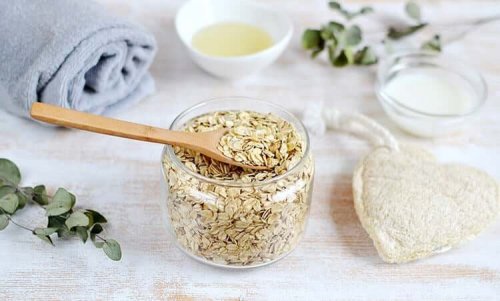
Oats and almonds are two of the best ingredients to exfoliate the skin in a natural way and to facilitate the elimination of dead skins cells. Also, this exfoliating face mask is really special since, in addition to exfoliating, it also has moisturizing properties.
Ingredients
- 50 grams of oats
- 2 teaspoons of almonds (12 grams)
- 2 drops of rose essential oil
- 1 tablespoon of moisturizing lotion
What should you do?
First, mix all the ingredients in a blender. Then, apply the cream over your entire face to exfoliate. Let it act for 15 minutes and then remove it with a soft cloth.
Read also: Masks for Eliminating Black Heads
Papaya mask
A hydrating fruit such as papaya is wonderful to use to make one of the most refreshing exfoliating face masks. Here, we combine it with a little honey, powdered comfrey leaf, and lavender oil.
Ingredients
- 2 tablespoons of papaya pulp
- 1 teaspoon of honey (7.5 grams)
- 2 drops of lavender essential oil
- 1 tablespoon of powdered comfrey leaf (Symphytum officinale)
What should you do?
First, mix all the ingredients in a bowl until it forms a paste. Then, apply it to your entire face, letting it act for 10 to 15 minutes. Finally, rinse off with lukewarm water.
Coffee mask
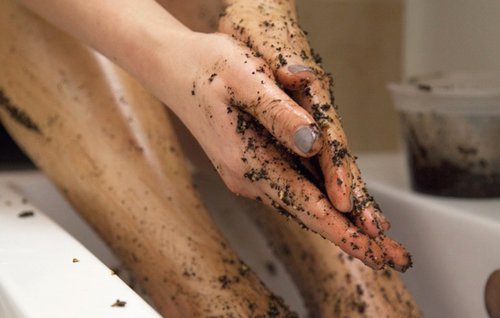
People have been using coffee as a natural exfoliant for a long time because of its texture. It’s good for the skin and facilitates the elimination of impurities, leaving the face clean and fresh, according to this study published in Theranostics.
Ingredients
- 1 tablespoon of ground coffee
- 3 tablespoons of moisturizing lotion
What should you do?
Mix both ingredients in a bowl and then apply it to your face with soft circular motions. Leave it on for 10 minutes and then wash it off.
Flaxseed and honey mask
This homemade exfoliating mask is ideal for removing dead skin cells and impurities in areas like the elbows and knees.
Ingredients
- 25 grams of flaxseed
- 1 cup of honey (335 grams)
- ½ cup of warm water (125 ml)
What should you do?
First, mix all the ingredients and keep them in the refrigerator for three hours; then, use it to clean your elbows and knees with a light massage. Finally, don’t forget to rinse off using warm water.
Sugar and lemon mask
This mask is great to exfoliate the skin and naturally lighten dark spots. However, it’s very important to apply it at night since the lemon causes light sensitivity and could lead to skin blemishes if exposed to the sun.
Ingredients
- 2 tablespoons of sugar (30 grams)
- The juice of ½ a lemon
What should you do?
First, mix the two ingredients and apply the mask with smooth circular motions. Leave it on for 15 minutes and then remove it with warm water.
You might also like: Natural Toners for Beautiful Glowing Skin
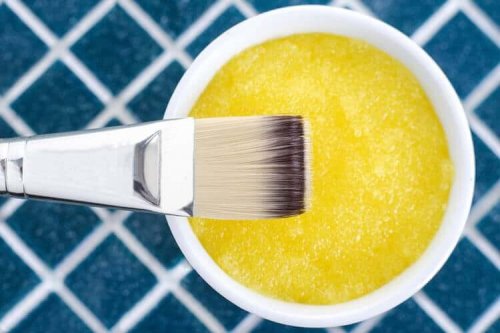
Buttermilk and salt mask
This natural exfoliating face mask is ideal to close open pores. Also, it helps eliminate excess oil from the skin and to obtain a smoother and softer texture.
Ingredients
- 3 tablespoons of buttermilk (45 ml)
- 1 tablespoon of salt
What should you do?
Mix both ingredients until it forms a paste and then apply it as an exfoliating mask with smooth circular motions. Then, rinse your face with warm water.
Honey and oats mask
Honey and oats have been used for centuries for skin health. According to a review published in the Indian Journal of Dermatology, Venereology, and Leprology, oats have antioxidant and anti-inflammatory properties that help treat dermatological conditions like a rash, atopic dermatitis, and itching
A study published in the Central Asian Journal of Global Health found that honey has antimicrobial and healing properties that can help treat skin conditions. Ready to try this next mask?
Ingredients
- 2 tablespoons of oats (20 g)
- 1 teaspoon of honey (7.5 g)
What should you do?
First, mix both ingredients well. and then apply it as a mask to your damp face being sure to cover it entirely. Then, leave it on for 20 minutes. Finally, remove it with warm water while massaging with smooth circular motion.
Now you know eight different exfoliating masks that you can make at home. Don’t forget to use with caution, once or twice a week. If you notice some change in your skin, talk to your dermatologist.
All cited sources were thoroughly reviewed by our team to ensure their quality, reliability, currency, and validity. The bibliography of this article was considered reliable and of academic or scientific accuracy.
- American Academy of Dermatology Association. (2019). How to safely exfoliate at home.
Available in https://www.aad.org/skin-care-secrets/safely-exfoliate-at-home - Pazyar, N., Yaghoobi, R., Kazerouni, A., & Feily, A. (2012, March). Oatmeal in dermatology: A brief review. Indian Journal of Dermatology, Venereology and Leprology. https://doi.org/10.4103/0378-6323.93629
- McLoone P, Oluwadun A, Warnock M, Fyfe L. (2016). Honey: A Therapeutic Agent for Disorders of the Skin. Cent Asian J Glob Health. 2016;5(1):241. Published 2016 Aug 4. doi:10.5195/cajgh.2016.241
- Lin, T. K., Zhong, L., & Santiago, J. L. (2018). Anti-inflammatory and skin barrier repair effects of topical application of some plant oils. International journal of molecular sciences, 19(1), 70. https://www.mdpi.com/1422-0067/19/1/70
- Li, Y. F., Ouyang, S. H., Tu, L. F., Wang, X., Yuan, W. L., Wang, G. E., … & Kurihara, H. (2018). Caffeine Protects Skin from Oxidative Stress-Induced Senescence through the Activation of Autophagy. Theranostics, 8(20), 5713. https://www.ncbi.nlm.nih.gov/pmc/articles/PMC6276298/
- Jiménez, P., Masson, L., & Quitral, V. (2013). Composición química de semillas de chía, linaza y rosa mosqueta y su aporte en ácidos grasos omega-3. Revista chilena de nutrición, 40(2), 155-160. https://scielo.conicyt.cl/scielo.php?pid=S0717-75182013000200010&script=sci_arttext
- Talamantes, C. S., Ninet, V. Z., Martinez, A. E., Pujalte, B. F., & Llatas, F. P. (2015). Reacciones de fotosensibilidad de origen exógeno: Fototoxia y fotoalergia. Enfermería Dermatológica, 9(26), 10-18. https://dialnet.unirioja.es/descarga/articulo/5444252.pdf
- Pazyar, N., Yaghoobi, R., Kazerouni, A., & Feily, A. (2012). Oatmeal in dermatology: a brief review. Indian Journal of Dermatology, Venereology, and Leprology, 78(2), 142. https://www.ncbi.nlm.nih.gov/pubmed/22421643
- McLoone, P., Oluwadun, A., Warnock, M., & Fyfe, L. (2016). Honey: A therapeutic agent for disorders of the skin. Central Asian journal of global health, 5(1). https://www.ncbi.nlm.nih.gov/pmc/articles/PMC5661189/
This text is provided for informational purposes only and does not replace consultation with a professional. If in doubt, consult your specialist.








